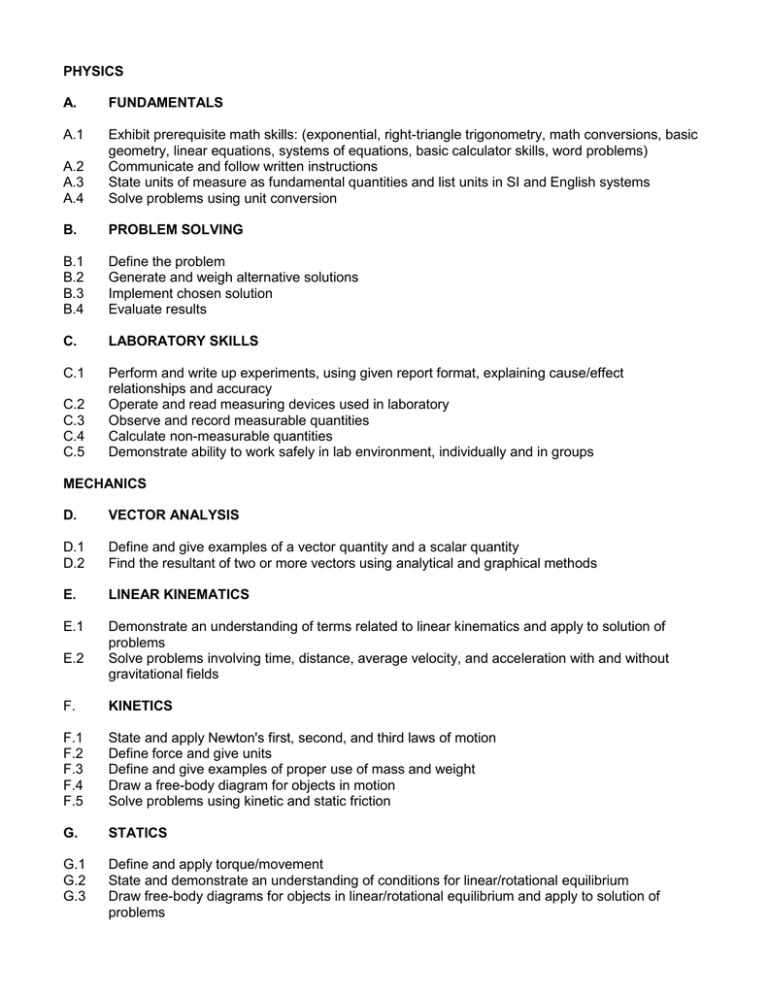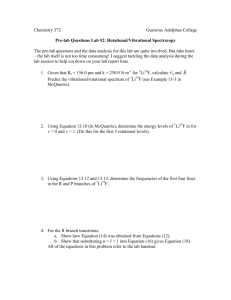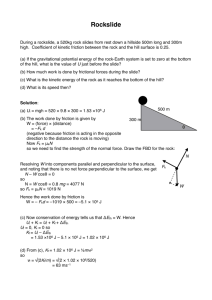PHYSICS A. FUNDAMENTALS
advertisement

PHYSICS A. FUNDAMENTALS A.1 A.2 A.3 A.4 Exhibit prerequisite math skills: (exponential, right-triangle trigonometry, math conversions, basic geometry, linear equations, systems of equations, basic calculator skills, word problems) Communicate and follow written instructions State units of measure as fundamental quantities and list units in SI and English systems Solve problems using unit conversion B. PROBLEM SOLVING B.1 B.2 B.3 B.4 Define the problem Generate and weigh alternative solutions Implement chosen solution Evaluate results C. LABORATORY SKILLS C.1 Perform and write up experiments, using given report format, explaining cause/effect relationships and accuracy Operate and read measuring devices used in laboratory Observe and record measurable quantities Calculate non-measurable quantities Demonstrate ability to work safely in lab environment, individually and in groups C.2 C.3 C.4 C.5 MECHANICS D. VECTOR ANALYSIS D.1 D.2 Define and give examples of a vector quantity and a scalar quantity Find the resultant of two or more vectors using analytical and graphical methods E. LINEAR KINEMATICS E.1 Demonstrate an understanding of terms related to linear kinematics and apply to solution of problems Solve problems involving time, distance, average velocity, and acceleration with and without gravitational fields E.2 F. KINETICS F.1 F.2 F.3 F.4 F.5 State and apply Newton's first, second, and third laws of motion Define force and give units Define and give examples of proper use of mass and weight Draw a free-body diagram for objects in motion Solve problems using kinetic and static friction G. STATICS G.1 G.2 G.3 Define and apply torque/movement State and demonstrate an understanding of conditions for linear/rotational equilibrium Draw free-body diagrams for objects in linear/rotational equilibrium and apply to solution of problems H. LINEAR DYNAMICS H.1 H.2 H.3 Define terms related to linear dynamics and apply to the solution of problems, using appropriate units Discuss and apply knowledge of the principle of conservation of energy State the law of conservation of linear momentum and solve related problems I. ROTATIONAL KINEMATICS I.1 I.6 Define terms related to rotational kinematics and apply to the solution of problems, using appropriate units Draw analogies relating angular motion to linear motion Describe and apply the relationship between force and displacement (Hooke's law) Discuss simple harmonic motion in terms of conservation of energy Derive the position, velocity, and acceleration for simple harmonic motion, using the reference circle Give examples for damped and undamped harmonic motion J. ROTATIONAL DYNAMICS J.1 J.2 J.3 J.4 Define terms related to rotational dynamics and apply to the solution of problems using appropriate units Define moment of inertia of a body and relate to its linear analog State and apply the rotational analog of Newton's second law State and apply the law of conservation of angular momentum K. WAVE MOTION K.1 Define, relate and apply frequency, period, wavelength, amplitude, wave velocity and give appropriate units for wave motion Differentiate between transverse and longitudinal wave motion Demonstrate an understanding of wave combination, using supposition principle Demonstrate an understanding of the propagation of sound I.2 I.3 I.4 I.5 K.2 K.3 K.4 HEAT L. HEAT ENERGY L.1 L.2 Demonstrate an understanding of terms, units and concepts related to simple thermodynamic processes Demonstrate an understanding of specific and latent heats and apply to solution of problems M. THERMAL PROPERTIES OF MATTER M.1 M.2 M.3 State and apply formulas for thermal expansion State and apply the ideal gas law to the solution of problems Define heat transfer by conduction, convection, radiation and solve related problems N. THERMODYNAMICS N.1 N.2 State the law of thermodynamics and apply to the solution of problems Define and apply thermodynamic processes and Carnot cycle ELECTROMAGNETICS O. ELECTROSTATICS O.1 O.2 O.3 O.4 Identify structure of an atom Demonstrate an understanding of electric charge and define its units State and apply Coulomb's law Demonstrate knowledge of electric field and apply to physical problems P. ELECTRICITY/DC CIRCUITS P.1 P.2 P.3 P.4 P.5 Define electrical terms and appropriate units and show relationship via Ohm's law Apply Ohm's law State and apply Kirchhoff's law Write and apply equations for a circuit containing resistors connected in series and parallel Determine nature and application of capacitors Q. MAGNETISM Q.1 Q.2 Define terms relating to magnetism State and apply equations relating to magnetism and derive appropriate units R. ELECTROMAGNETISM/AC CIRCUITS R.1 R.2 R.3 R.4 R.5 Define electrical terms germane to AC circuits State and apply Faraday's law and Lenz's law Explain the operation of inductors, transformers, solenoids, generators and motors State and apply equations for a series AC circuit, including appropriate units Describe properties of electromagnetic waves S. OPTICS S.1 S.2 S.3 Discuss the dual behavior of light Demonstrate an understanding of reflection and refraction of light Define optical terms and utilize mathematical and graphical techniques for mirrors and lenses T. MODERN PHYSICS T.1 T.2 Identify current topics related to physics; e.g., laser, plasma technology, quantum mechanics Discuss principles of solid state technology DACUM PANEL PARTICIPANTS OCCUPATIONAL PANELISTS Jesse Krech, Senior Tool Engineer, Duracell, Lancaster, SC Mark McDonald, Product Specialist, Carolina Fluid Components, Charlotte, NC Bruce Randall, Electronic Engineer, Process Systems, Charlotte, NC Dick Schneider, Manager, Current Product Engineering, Joslyn Clark Controls, Lancaster, SC FACULTY COMMITTEE Joe Avampato, Department Manager, Electronics Engineering Technology, York Technical College, Rock Hill, SC Ed Braun, Chairman, Department of Engineering Technology, University of North Carolina at Charlotte, Charlotte, NC Frank Caldwell, Department Manger, Mathematics and Sciences, York Technical College, Rock Hill, SC Linda Knight, Department Manager, College Transfer, York Technical College, Rock Hill, SC David LeGrande, Department Manager, Civil Engineering and Graphics Technology, York Technical College, Rock Hill, SC Margaret Ruiz, Physics Instructor, York Technical College, Rock Hill, SC Herman Yawn, Department Manager, Mechanical Engineering Technology, York Technical College, Rock Hill, SC FACILITATOR Louise C. Rhyne, Dean of Learning Resources, York Technical College, Rock Hill, SC RECORDER Sylvia L. LaValle, CPS, Administrative Specialist, York Technical College, Rock Hill, SC DATE/LOCATION March 5, 1991 York Technical College 452 S. Anderson Road Rock Hill, SC 29730





